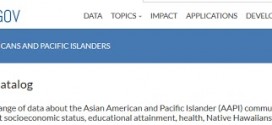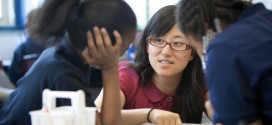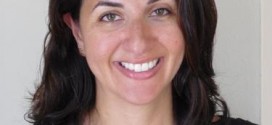By Heidi Zheng
As one of America’s longest running American reality television shows, America’s Next Top Model just commenced its 21st cycle. More remarkably, this is the second season featuring both male and female contestants. Diversity, rejoice!
…Not so quick. Given the producer and presenter Tyra Banks is black herself, diversity has never been an issue on ANTM. That being said, Asian faces are still a rare sight on the show. As their Wikipedia page eagerly points out, this year’s one and only Asian American contestant Andrea “Shei” Phan’s hometown is “Oklahoma City, Oklahoma (heritage from Vietnam).” Although another ethnically distinct contestant, Mirjana Puhar, is also merited a parenthetical addendum, she is “originally from Serbia,” whereas Phan is a second-generation Asian American, born and raised right here in the US of A.

It is yet too early to see if Phan fits the traditional bill for That Asian Girl (read: cutesy and meek), but we’ve seen our fair share of Asian American stereotypes on TV. Fashion-related shows are not the only ones that cast mannequins; as more and more Asian Americans enter mainstream entertainment, the range of stock characters expands accordingly, spanning across a solid spectrum of weird, unpleasant if not downright annoying.
You have the hardworking, run-of-the-mill first generation immigrant on Project Runway who is always anxious and on the verge of tears; then there is the garrulous millennial in MTV’s Rich Kids of Beverly Hill who boasts of her daddy, a self-made millionaire that has once been, well, that run-of-the-mill, hardworking first generation immigrant.

Also, let’s not forget Arthur Chu, the “Villain of Jeopardy,” who got his none-too-flattering moniker for his unconventional way of gaming the rules. Allow my inner conspiracy theorist, but this new development of a threatening meanie rather than the brainy but demure sidekick seems to coincide with the rapid rise of East Asian economies (i.e. Chu’s native China, the US’s largest debt holder) It may be interesting to note that Chu’s day job is a voice actor. His specialty? Fake Chinese accent.

It is not just me with my ultra-sensitive Asian-dar scanning the screen for my kinsmen; performance artist Kristina Wong told CNN that she chose reality TV specifically to “show an Asian American story that had not been told…other Asian women [her] age on scripted television…are usually side characters handing over scalpels playing someone’s badly accented mother or are scantily clad.” But to what degree is reality TV reflective of the reality that so many of us breathe day in and day out, outside the camera’s panoptic gaze?
Granted, reality TV shows have their own agenda to assemble a dramatic narrative, or, as an industry insider once told Asian Fortune, to “bitchify.” The spin that each show puts on their otherwise unfiltered raw footage is then very telling of the production team’s aesthetics, perspective, and unfortunately, when it comes to race and ethnicity, preconceived notions.
Maybe it’s not fair to blame it solely on the showrunners. After all, they are just salesmen pitching what they think meets the market’s need. The resilience of these larger-than-life stereotypes works perfectly for the audience: dramatic yet well expected, a glimpse of the exotic from inside the comfort zone. Mild and manageable – just like we Americans love our curry. But 2014 is about time that we stomach the Reality with a capital R. “Some like it hot” is not an option if we are determined to go forth as a society.
Worse yet is the backhanded publicity that the Asian American community either unconsciously or intentionally perpetrates, particularly among the stand-up subculture. Observational comedy, being inherently satirical, blows things out of proportion to maximize the farcical effect. Some of the most atrocious racial stereotypes actually come from comics whose repertoire consists of nothing but self-derogatory jokes, i.e. Russell Peters, Hari Kondabolu, Kumail Nanjiani.
We all love a good insider’s joke, but if we keep to ourselves and produce art that is not fit for crowd-friendly, cringe-free enjoyment, when can we finally break the bamboo cell? Commercial success does not necessarily translate into social acceptance, and feeding notoriety for cash only leads to collective starvation in the long run.
One may argue that Peters, among many others, have a fan base that consists of people from all walks of life across ethnic groups. Which only poses a bigger problem: why advertize ourselves as such? Why reinforce the negative image and keep it in circulation? If One of Our Own stamps approval of the appallingly inaccurate and unflattering portrayal, it is only fair that non-Asian Americans are also free to perpetuate it. And aren’t some of them keen on doing just that.
One may also argue that stereotypes are, to a certain extent, grounded in reality; they are able to strike a chord in us because they speak true to our own experience. If the reality at present is something from which Asian Americans are combating to steer clear, is reality TV prorogating or hindering the progress?
We often hear our peers say that growing up, there were few that looked like us on television, and many of us wanted to be blond or tan like the singular standard of beauty that the media championed. Do we want our kids to grow up thinking they should be like the oft-bullied nerd or the materialistic gold-digger on prime time television? Are those grotesquely burlesque typecasts the appropriate role models for the younger generation to mimic?
There, I may just have done it myself – a grossly serious Asian geeking the hellokitty out of something as trivial as reality TV. But we are not Type A for nothin’, after all.
 Asian Fortune Your source for all things Asian American
Asian Fortune Your source for all things Asian American



